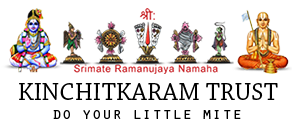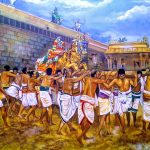Srimathe Rangaramanuja Mahadesikaya Namaha
Srimathe Sri Varaha Mahadesikaya Namaha
Sri Velukkudi Krishnan Swamy Thiruvadigaley Sharanam
Swamy,
What should be followed as best pracitces in dealing with Charama Thirumeni?
Why certain thirumeni are onlly eligble for Brahma Medha SamskAram?
After the soul leaves, how does it matter what kind of human being was while living?
Dasanudasan
Charama Thirumeni Best Practices
- Liked by
Srimathe Ramanujaya Namah
Adiyen will try to answer to the best of my knowledge.
Best Practices in Dealing with Charama Thirumeni
1. **Respect and Reverence**: The body (Charama Thirumeni) should be treated with utmost respect and reverence as it was the temple in which the soul resided. The body is seen as sacred because it was the vehicle through which the soul engaged in bhakti (devotion) and other dharmic activities.
2. **Ritual Purity**: Traditional practices emphasize maintaining ritual purity during the handling of the Charama Thirumeni. This includes specific bathing, dressing, and adornment with appropriate symbols (such as applying Thiruman and Sri Churnam) as a mark of respect.
3. **Recitation of Prayers**: During the final rites, specific mantras and verses from the Divya Prabandham or other scriptures are recited to ensure the soul’s journey to Srivaikuntha, the eternal abode of the Supreme Being, is smooth and guided by divine grace.
4. **Conducting the Last Rites**: The last rites should be conducted in accordance with the prescribed shastras (scriptures). This includes the specific steps involved in the funeral rituals, which are aimed at ensuring that the soul is liberated from the cycle of rebirth and attains moksha.
Eligibility for Brahma Medha SamskAram
**Brahma Medha SamskAram** is a special funeral rite traditionally reserved for certain individuals based on their spiritual and religious standing. This rite is typically performed for:
1. **Acharyas and Sannyasis**: Those who have renounced worldly life and have dedicated themselves to spiritual pursuits, teaching, and guiding others in the path of dharma are eligible for Brahma Medha SamskAram.
2. **Highly Pious Individuals**: Individuals who have led a life of exemplary piety, devotion to Sriman Narayana, and adherence to dharma might also be considered for this ritual, especially if they have had a significant impact on their community’s spiritual life.
Significance After the Soul Leaves
Once the soul (Atman) leaves the body, the type of person one was in life—whether righteous or unrighteous—matters in the context of karmic consequences and the journey of the soul:
1. **Karmic Consequences**: The actions (karma) performed during one’s lifetime determine the soul’s future journey. Righteous actions lead to the accumulation of punya, aiding in the soul’s progress towards moksha. Adharmic actions accumulate pāpa, leading to further cycles of birth and rebirth.
2. **Spiritual Journey**: The last rites and rituals, such as Brahma Medha SamskAram, are intended to help the soul transcend this world and reach Srivaikuntha. The conduct of these rites reflects the life led by the individual and their standing within the community and spiritual tradition.
3. **Divine Perspective**: From a spiritual perspective, while the soul itself is eternal and unchanging, the life lived in the material world impacts its progress towards moksha. The nature of one’s life—dharmic or adharmic—affects how smoothly the soul can proceed towards liberation.
In summary, the practices surrounding the Charama Thirumeni, eligibility for Brahma Medha SamskAram, and the significance of one’s actions after the soul departs are deeply interwoven with the principles of karma, dharma, and the ultimate goal of attaining moksha.
Hope this helps Swami!
adiyen,
Badrinarayana Ramanuja Dasan.
- Liked by

